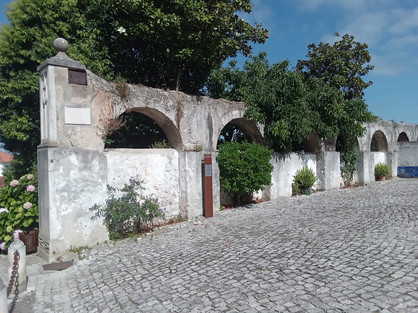Discovering the West- II
- Catarina Araújo

- Aug 14, 2021
- 8 min read
Updated: May 8
Obidos

The town of Obidos is a jewel of Portugal. Located on the top of a hill, Obidos, which means "fortified city", was fortified since ancient times and still preserves its medieval layout. Its labyrinthine streets and flower-decked houses, provide a very romantic and picturesque atmosphere. His castle was elected in 2007, as one of the 7 Wonders of Portugal.
Throughout the year there are several festivities that attract many visitors, such as the International Chocolate Festival, the Obidos Medieval Market, Obidos Christmas Village and the Obidos International Literary Festival. Outside these dates, this charming village continues to be visited daily by a large number of tourists, being a place full of life and animation.
The House of Queens
The history of Obidos is closely related to the royal family, especially to the queens of Portugal. In 1210 the village was donated to D. Urraca by King D. Afonso II, in 1282 D. Dinis and Queen Santa Isabel spend their wedding in Obidos and D. Dinis offers the village of Obidos to his wife as a wedding gift. From this date onwards, the town becomes an integral part of the dowry of all Portuguese queens. This is the main reason why we can find so many churches in Obidos. Queen D. Leonor also lived here after her son's death and founded the Mercy of Obidos.
Obidos, Literary Village
In 2015, Obidos was considered a Creative City of Literature by Unesco and started to integrate the Creative Cities network, but the Obidos Literary Village project started in 2011, with the objective of requalifying the historic center. In 2012, the largest Portuguese bookshop inside a church was created, in the Church of Santiago, located inside the village walls, next to the entrance to the Castle. After the creation of this cultural hub, 11 new bookstores were born and even a literary hotel, The Literary Man. Several authors seek out Obidos for literary residences, to develop their projects and make their presentations.

We visited Obidos late in the afternoon in the beginning of the summer. We walked through the alleys, up to the Castle and did not leave without drinking the famous Ginginha de Óbidos in a glass of chocolate. We'll share our script here.
Tip: Don't forget to bring your camera.
We left the car in one of the parks next to the Aqueduto da Usseira and started our tour there.
Aqueduto da Usseira
Usseira Aqueduct
This aqueduct was built in 1573 and spans about 6 km, divided into covered and underground sections. Originated from a water source in Usseira, the aqueduct supplied the Chafariz Real (Royal Fountain) at Praça de Santa Maria (Saint Mary Square) and another source, Mãe D'Água, next to Porta da Vila (Village Door), which was destroyed in the 20th century. Built by Queen Catherine of Austria, it was the first water supply system in Obidos. Its arcades display perfect arches.
Porta da Vila and Oratório da Nossa Senhora da Piedade
Village Door and Our Lady of Mercy's Oratory
Built in 1536, this door shelter the oratory dedicated to the Saint Patron of Obidos, Nossa Senhora da Piedade. The tiles in the oratory represent biblical scenes.
Urban Center of Obidos
Passing Porta da Vila (Village Door), we enter the walled city. From here you can take the main street - Rua Direita - which will connect Porta da Vila to the Castle. On this street you can find several cafes and craft shops. It is here that the noble and wealthy houses are concentrated. Alongside Rua Direita, the other two main streets are Rua de Cima and Rua de Baixo.
Enter the secondary streets and wander through the alleys and stairs looking for the charming corners, the Manueline porticoes and the stonework on doors and windows, to be captured with your camera.
The walkways over the street connect to the outbuildings and backyards of the houses that are on another block.
Largo de São Pedro
St. Peter's Square
A more open space where various religious and civil buildings are concentrated, such as the Igreja de São Pedro (Saint Peter's Church), the Capela de São Martinho (Saint Martin's Chapel) and the Paços do Concelho (municipal offices).
The Igreja de São Pedro is one of the most important in the village. It was built in the 12th and 13th centuries, destroyed in the 1755 earthquake and rebuilt with Baroque and neoclassical elements. Here is where the painter Josepha de Óbidos is buried.
The Capela de São Martinho is a property of public interest. It was built in the 14th century in a remarkable Gothic style and today functions as a funerary chapel.
The Paços do Concelho building, or Vigararia Palace, is an example of civil and mannerist architecture. It was built in the 16th and 17th centuries for the residence of Obidos general vicars. In the 19th century, the City Council was transferred here.

Praça de Santa Maria
Saint Mary Square
Expanded in the 16th century by D. Catarina of Austria, with the demolition of pre-existing buildings.
It has a group of religious and military buildings: the Igreja de Santa Maria (Saint Mary's Church, Matrix of Obidos), the Pelourinho (Pillory), the Chafariz (Fountain), the Village Market, the Aboins Manor , the Brito Pegado Manor and the Old Paços do Concelho.
Obidos Castle
The Obidos Castle has remote origins. It would have been a Castro, later taken by the Romans, by the Arabs and, in 1148, by the Christians, during the reign of D. Afonso Henriques.
In the 30s of the 20th century, through the action of the DGEMN, the Castle and the walls were endowed with battlements, in an attempt to restore the building to its medieval image. At this time, the towers were also rebuilt and, on the site of the former Paço, an inn (Pousada) was built. It is the first inn of the State in a historic building. In the Pousada, you have the possibility to have a true medieval experience and stay overnight in the Castle.
At this time, the entire town was endowed with an aesthetic homogeneity, through the painting with whitewash of all the facades and the standardization of the pavement of the streets.
Climb to the walls to enjoy the views: to the west you have Várzea da Rainha (Queen's floodplain) and, to the east, the outskirts of Obidos and the Bom Jesus da Pedra Sanctuary. Be careful as the walls have no protection.
Igreja de Santiago
Santiago's Church
The Igreja de Santiago was erected by King D. Sancho I in 1886, probably in the place where the Islamic mosque stood. This church provided spiritual assistance to the military and the court of queens when they were in Obidos. It was deeply damaged in the 1755 earthquake and rebuilt in neoclassical baroque style.
It was in this church that the Livraria Santiago (bookstore) was installed, where you can find a wide variety of books. When we go up the stairs to the church choir, we find a space where poetry and bobbin lace (renda de bilros) are combined. It is here that Natália Santos, the Rendeira Poet , works, exhibits and sells her jewelery in bobbin lace. We chatted for a while and she showed us her poems, her jewelery works, photographs and newspaper clippings from occasions when she was invited to television programs.
Obidos Cinegetic Park
Situated on the west slope of the village and overlooking Várzea da Rainha, this park invites you to take a walk with an attentive eye as two families of fallow deer and other animals such as foxes, wild boar, partridges and wild ducks live there.
You can start the trail at Porta da Talhada (image on the left) and follow the trail of the cinegetic park for about 1km. The route connects with the Capela de S. João de Mocharro (chapel), which is currently the Capela da Nossa Senhora do Carmo (Our Lady of Carmo Chapel), and ends at the Postigo do Jogo da Bola, where there is a magnificent viewpoint over the village.
Torre dos Maneys
Maneys Tower

We were very curious about this building we had photographed, with its beautiful ogival doors and windows, so we went searching and, here's what we've found:
It dates back to the 16th century and is thought to have been the Storage Tower from Obidos Castle.
It is connected to the house in front by a covered bridge.
It was in ruins when it was bought by a family who often came to Obidos for vacations.
After several restoration works and many historical finds, it served as a holiday home for many years.
In 2014 it was converted into Housing Tourism.
It has 5 rooms with the name of some members of the family, all of which have the name Manuel in common.
That's where its name probably came from (Torre dos Manuéis).
Biological Market Bookstore
This space houses the Biological Market and a bookstore - Livraria do Mercado. When passing by Rua Direita, be sure to visit this bookshop, where the bookshelves are made with reused fruit boxes.
Baloiço de Óbidos
Obidos Swing
Located in the Serrinha de Cima viewpoint, this two-seater swing provides relaxing moments with panoramic views over the village.
Porta and Oratório da Nossa Senhora da Graça
Door and Oratory of Our Lady of Grace
We leave the city walled by the Porta and Oratório da Nossa Senhora da Graça, on the east side. It has inside a chapel-oratory dedicated to Our Lady of Grace, whose image is said to have been offered in thanksgiving after the siege of 1246 in a dispute between D. Sancho II and D. Afonso III. This chapel-oratory was renovated by Bernardo de Palma in the 18th century, "in fulfillment of a promise made by his daughter, who died because of a contradicted love affair for a young Obidense". The door turret now has a chancel, altarpiece, choir, tribune and sacristy.
In the past, before the creation of Rua Direita, it was the main access to the town of Obidos.
Museums
During our short visit we did not enter any museums, but we leave a list here for reference:
Obidos Municipal Museum
We highlight the collection of paintings from the 16th and 17th centuries, which includes works by the painter Josefa de Óbidos, a baroque painter from the 17th century.
Obidos Parish Museum
Abílio de Mattos e Silva Museum and House of the Arco da Cadeia
NovaOgiva Gallery
Interior Design Center
The Ginja de Óbidos
The fruit
It is known that the fruit (a kind of cherry), originates from Asia and was brought by the Romans. Due to the knowledge of its digestive and diuretic medicinal properties, it was widespread in Europe.
From medicinal syrup to liqueur
To produce the liquor it was necessary to invent two raw materials: alcohol and sugar. It was the medieval monks and abbots who, by increasing the brandy content of medicinal syrups, invented liqueurs and spirits drinks. The convent recipe was then passed on to the families from Obidos.
There are several types of liqueurs, simple or flavored with fruit, cinnamon or vanilla. The tastiest are those produced by hand and only with ingredients of natural origin, such as the Oppidum brand.
"Drink the ginja and eat the cup"

The ginja in a chocolate cup is a classic and is on sale throughout the town. It all started at the Chocolate Festival in Obidos, in 2005, when Dário Pimpão, founder of Oppidum, acquired a box of chocolate cups and tried selling the ginja liqueur in these cups.
Other points of interest in Obidos
Lagoa de Óbidos (Obidos Lagoon)
Obidos Lagoon is the largest coastal lagoon on the Portuguese coast and the only survivor of three large lagoons in the West, since the Neolithic period. It is fed by sea water through the connection known as "Open" and fresh water from the rivers Real, Arnóia and Cal, which flow there.
Since the 15th century, the population have been fighting against the announced end of the Lagoon, through its regular opening to the sea, threatened by silting.
Santuário do Senhor Jesús da Pedra (Sanctuary of Lord Jesus of Stone )
This temple is located outside the village, on the road to Caldas da Rainha. It was designed by the architect Captain Rodrigo Franco and dates from 1747. It has an unique character, on the outside it has the volume of a cylinder and on the inside a hexagonal polygon, in addition to a game of symmetries with inverted windows. On the main altar of this sanctuary and pilgrimage place, there is a carved image of Jesus Crucified on a Stone Cross associated with a very ancient cult related to bad agricultural years.
























Comments